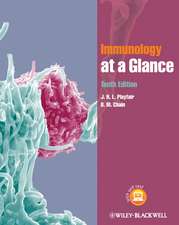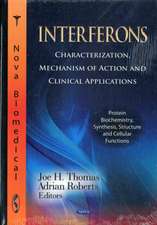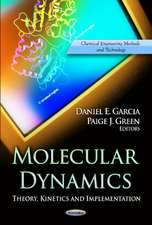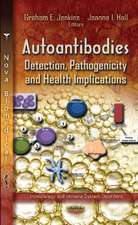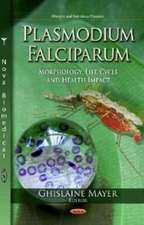Avian Immunology: Advances in Experimental Medicine and Biology, cartea 88
Editat de A. Benedicten Limba Engleză Paperback – 12 dec 2012
Din seria Advances in Experimental Medicine and Biology
- 9%
 Preț: 719.60 lei
Preț: 719.60 lei - 20%
 Preț: 691.93 lei
Preț: 691.93 lei - 5%
 Preț: 717.00 lei
Preț: 717.00 lei - 5%
 Preț: 716.28 lei
Preț: 716.28 lei - 5%
 Preț: 717.20 lei
Preț: 717.20 lei - 15%
 Preț: 640.24 lei
Preț: 640.24 lei - 5%
 Preț: 1113.83 lei
Preț: 1113.83 lei - 5%
 Preț: 715.71 lei
Preț: 715.71 lei - 5%
 Preț: 820.43 lei
Preț: 820.43 lei - 15%
 Preț: 641.38 lei
Preț: 641.38 lei - 5%
 Preț: 716.28 lei
Preț: 716.28 lei - 5%
 Preț: 523.99 lei
Preț: 523.99 lei - 5%
 Preț: 1031.00 lei
Preț: 1031.00 lei - 5%
 Preț: 717.00 lei
Preț: 717.00 lei - 5%
 Preț: 715.35 lei
Preț: 715.35 lei - 20%
 Preț: 1161.71 lei
Preț: 1161.71 lei - 5%
 Preț: 1170.51 lei
Preț: 1170.51 lei - 18%
 Preț: 1119.87 lei
Preț: 1119.87 lei - 5%
 Preț: 1288.48 lei
Preț: 1288.48 lei - 5%
 Preț: 1164.67 lei
Preț: 1164.67 lei - 5%
 Preț: 1101.73 lei
Preț: 1101.73 lei - 18%
 Preț: 1123.67 lei
Preț: 1123.67 lei - 5%
 Preț: 1435.64 lei
Preț: 1435.64 lei - 20%
 Preț: 1044.10 lei
Preț: 1044.10 lei - 18%
 Preț: 946.39 lei
Preț: 946.39 lei - 5%
 Preț: 292.57 lei
Preț: 292.57 lei - 18%
 Preț: 957.62 lei
Preț: 957.62 lei - 18%
 Preț: 1235.76 lei
Preț: 1235.76 lei - 5%
 Preț: 1231.55 lei
Preț: 1231.55 lei - 5%
 Preț: 1292.30 lei
Preț: 1292.30 lei - 5%
 Preț: 1102.10 lei
Preț: 1102.10 lei - 18%
 Preț: 1132.81 lei
Preț: 1132.81 lei - 5%
 Preț: 1165.19 lei
Preț: 1165.19 lei - 5%
 Preț: 1418.48 lei
Preț: 1418.48 lei - 5%
 Preț: 1305.63 lei
Preț: 1305.63 lei - 18%
 Preț: 1417.72 lei
Preț: 1417.72 lei - 18%
 Preț: 1412.99 lei
Preț: 1412.99 lei - 24%
 Preț: 806.16 lei
Preț: 806.16 lei - 18%
 Preț: 1243.29 lei
Preț: 1243.29 lei - 5%
 Preț: 1429.44 lei
Preț: 1429.44 lei - 5%
 Preț: 1618.70 lei
Preț: 1618.70 lei - 5%
 Preț: 1305.12 lei
Preț: 1305.12 lei - 18%
 Preț: 1124.92 lei
Preț: 1124.92 lei - 5%
 Preț: 1097.54 lei
Preț: 1097.54 lei - 15%
 Preț: 649.87 lei
Preț: 649.87 lei - 5%
 Preț: 1097.54 lei
Preț: 1097.54 lei - 18%
 Preț: 945.79 lei
Preț: 945.79 lei - 5%
 Preț: 1123.16 lei
Preț: 1123.16 lei
Preț: 726.15 lei
Preț vechi: 764.37 lei
-5% Nou
Puncte Express: 1089
Preț estimativ în valută:
138.99€ • 151.03$ • 116.83£
138.99€ • 151.03$ • 116.83£
Carte tipărită la comandă
Livrare economică 21 aprilie-05 mai
Preluare comenzi: 021 569.72.76
Specificații
ISBN-13: 9781461341710
ISBN-10: 146134171X
Pagini: 428
Ilustrații: XVI, 408 p. 57 illus.
Dimensiuni: 170 x 244 x 22 mm
Greutate: 0.68 kg
Ediția:Softcover reprint of the original 1st ed. 1977
Editura: Springer Us
Colecția Springer
Seria Advances in Experimental Medicine and Biology
Locul publicării:New York, NY, United States
ISBN-10: 146134171X
Pagini: 428
Ilustrații: XVI, 408 p. 57 illus.
Dimensiuni: 170 x 244 x 22 mm
Greutate: 0.68 kg
Ediția:Softcover reprint of the original 1st ed. 1977
Editura: Springer Us
Colecția Springer
Seria Advances in Experimental Medicine and Biology
Locul publicării:New York, NY, United States
Public țintă
ResearchCuprins
Lymphoid Development.- Ontogeny.- Ontogeny of Myelopoietic Precursor Cells in the Chicken Embryo.- Ontogeny of Hemopoietic Colony-forming Units in the Chick Embryo Spleen.- Differentiation of the Primary Lymphoid Organs in Avian Embryos: Origin and Homing of the Lymphoid Stem Cells.- Cell Transplantation into Immunodeficient Chicken Embryos - Reconstituting Capacity of Different Embryonic Cells.- Migration Patterns of Avian Embryonic Bone Marrow Cells and Their Differentiation to Functional T and B Cells.- B Cell Maturation.- Unique Aspects of Immunoglobulin Expression During Early B Cell Differentiation in the Chicken.- Analysis of Immunoglobulin Receptors During Antigen-induced Maturation of B Cells.- Lymphocyte Antigens, Receptors, and Factors.- The Production of a Lymphocyte Inhibitory Factor (LyIF) by Bursal and Thymic Lymphocytes.- Detergent Solubilization of B-lymphocyte Immunoglobulin.- Association of Lymphocyte Alloantigen Genotypes with Levels of Immune Responses.- Rosette Formation in Chicks: with Special Reference to QRBC-Rosettes.- Regulation of the Immune Response.- Tolerance.- Protein-induced Neonatal Specific and Non-specific Immunosuppression.- The Role of the Adherent Cell in Antigen-Antibody Complex Induced Immune Unresponsiveness.- Suppressor Cells.- Infectious Agammaglobulinemia: Suppressor T Cells with Specificity for Individual Immunoglobulin Classes.- Further Characterization of the Sensitizing Bursa Cells and of the Target for Suppression in the Transfer of Agammaglobulinemia.- Regulatory Lymphocytes from Anti-y Bursectomized Agammaglobulinemic Chickens.- Regulatory Lymphocytes in T Cell Functions in Chickens.- Inherited Immunodeficiency.- Inherited Iiranunodeficiency in Chickens: A Model for Common Variable Hypogammaglobulinemia in Man?.- MajorHistocompatibility Comple.- Structure.- Isolation and Partial Characterization of the Major Histocompatibility Antigen in the Chicken.- Some Recent Recombinants at the B Locus.- The Structure of the Major Histocompatibility Complex of the Chicken.- Immune Response.- Immune Response Genes in Chickens: The Multifarious Responsiveness to (T,G)-A—L.- Immune Response and Adult Mortality Associated with the B Locus in Chickens.- Cell Interactions.- Histocompatibility Requirements for Cellular Cooperation in the Chicken.- Allo-aggression in Chickens: Analysis of the B-Complex by Means of GVH Splenomegaly and by Inhibitory Antibodies.- Cell Transfer Studies with the DK/OR Inbred Chicken Lines.- Disease.- Role of the Major Histocompatibility Complex in Resistance to Marek’s Disease: Restriction of the Growth of JMV-MD Tumor Cells in Genetically Resistant Birds.- The Influence of the Major Histocompatibility Locus on Marek’s Disease in the Chicken.- Genetic and Cellular Control of Spontaneous Autoimmune Thyroiditis in OS Chickens.- Inbred Lines.- Syngeneic Inbred Lines of Chickens and Their Use in Immunogenetics.- Tumor Immunity.- Induction in B2/B2 Chickens of Immunity to Transplantable Carcinogen-induced Fibrosarcomas Mediated by T-cell Monocyte Cooperation: Role of Delayed Hypersensitivity to Unrelated Antigens.- Role of Tumor Antigen in Vaccine Protection in Marek’s Disease.- Immune Responses and Prevention of Lymphoid Leukosis Tumors in Chickens Fed an Androgen Analog.- Immunoglobulins.- Allotypes.- Genetic Polymorphism of Chicken 7S Immunoglobulins.- A Note on Unexpected Chicken 7S Immunoglobulin Allotypes.- Chicken High Molecular Weight Immunoglobulin (IgM) Allotypes: Localization on the Heavy Chains and Proposed Nomenclature.- Binding Site.- Comparison of theMicroenvironment of Chicken and Rabbit Antibody Active Sites.

